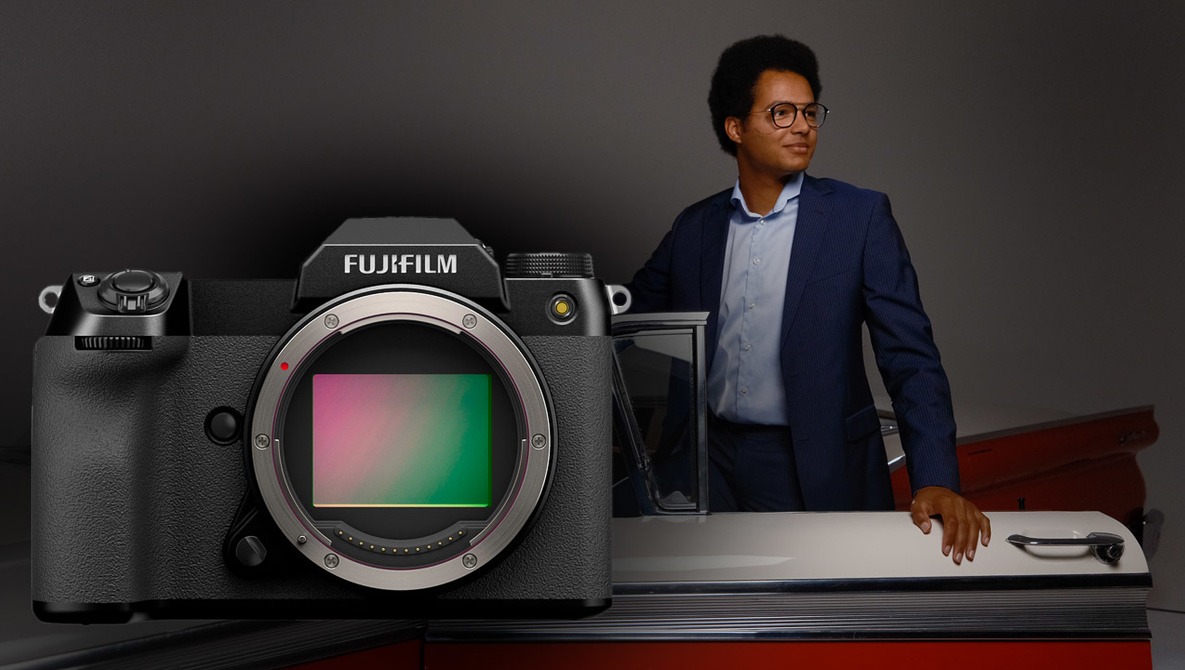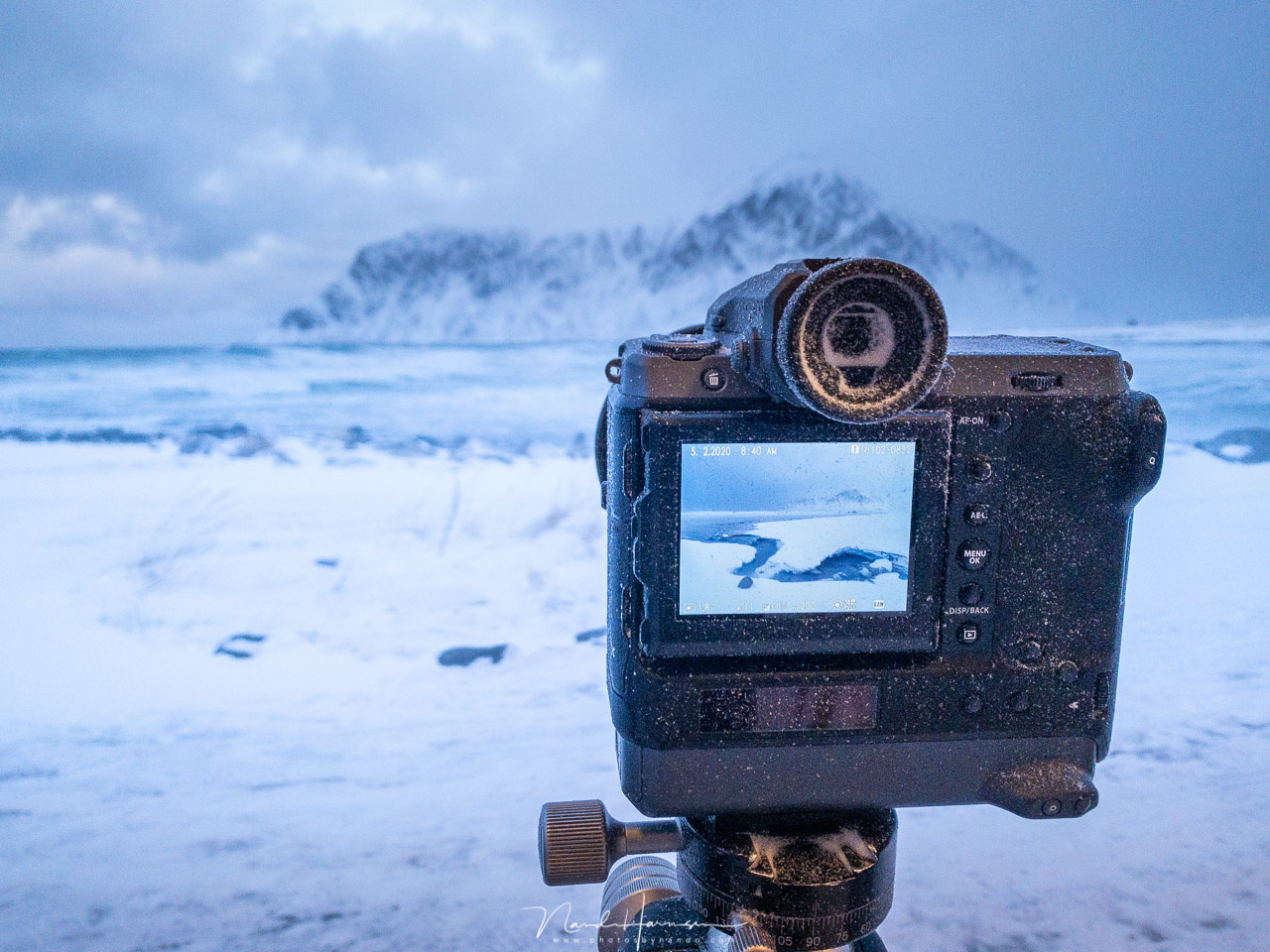I was invited for the introduction of the new Fujifilm GFX50S II at Fujifilm Netherlands. Besides the introduction to this new mirrorless medium format camera, I was able to use a pre-production model in the studio. In this article, I will share my first impressions of this new camera and compare it with the first version.
In 2017 I was asked to review the first affordable digital medium format camera. This was the Fujifilm GFX 50S, a camera the size of a regular DSLR. I took the camera to the Opal Coast in France and used it at different locations in the Netherlands for an extended review.
Although I did like the camera and its results, there were a few things that bothered me. The large extruded back was one thing, but also the quality of the command wheels in the front and back weren't up to par. It had the traditional dials on the top of the camera and it was possible to exchange the electronic viewfinder. Shooting with the GFX 50S felt slow and autofocus tracking was impossible.
But the results were amazing. It had great detail and showed a large dynamic range. I seriously considered buying this camera. But I didn't, because it wasn't fast enough for my kind of photography.
More Fujifilm Medium Format
Fujifilm announced another variant of the GFX 50S. This one was called the GFX 50R. Built around the same sensor, the camera was less bulky compared to the S-version. Then the GFX 100 came along. A huge and heavy medium format camera that offered 100 mp of resolution in a pro-body design that looked quite similar to the Nikon D6 and Canon EOS 1D Mark II. I took the GFX 100 to Lofoten where I used it in rough winter conditions.
There was one thing that I found disappointing. Although all these cameras produced amazing quality photos, the controls lacked quality. The buttons felt cheap and flimsy, just like the command wheels. Every time I turned a command wheel I had to be careful not to press them on accident, thus activating a function I didn't want.
Just like the R version of the GFX 50S, Fujifilm also released an S version of the GFX 100 in a completely new body design. Unfortunately, I haven't had the opportunity to use this new 100 mp camera with its new design.
The Fujifilm GFX 50S II
Now there is the second version of the GFX 50S. It's a completely different camera compared to its predecessor. It has the same body design as the GFX 100S though. Just like the 100 mp version, the new GFX 50S II has a lot of new features thanks to the X-Processor 4.
Now, the GFX 50S II lacks the shutter dial and the exchangeable electronic viewfinder. The extruding backside is gone and the top plate has the same large LCD screen as the GFX 100S. Using the camera feels like using a normal full frame camera.
The reason why the GFX 50S II has lost its physical dials has to do with the possibility to change functions by firmware updates, Fujifilm explained. When using physical dials you are limited to whatever the dial is designed for. Although it is a shame these traditional dials are lost, it is an understandable decision.
Most striking is the build quality of the command wheels. The GFX50S II is the first Fujifilm camera I used that has significantly better quality command wheels. These are more robust and have a nice feel to them. There is still room for improvement on the buttons, though. For instance, the AF-ON button is a bit too small and not in the best position.
The back LCD screen can be tilted in two directions which makes shooting in portrait position just as comfortable. It's a good design and perhaps even better compared to a fully tilted screen. The design makes it impossible to rotate it to the front of the camera, but that isn't a deal-breaker. After all, the Fujifilm GFX 50S II is no video camera; It can only record in 1080p at 25 or 30 frames.
The Most Important New Features
Compared to the original GFX 50S the new GFX 50S II is a more capable camera with a better design altogether. It now has the new X-Processor 4 which allows a lot of new possibilities according to Fujifilm. The list of improvements over its predecessor extends to 79 new and improved features which include:
- Eye/face-detection
- Better sensor performance
- Improved 6.5 stops IBIS
- Improved AF tracking
- New film simulations like Nostalgic Neg
- Better ergonomics
- Weighs only 900 grams
- Pixel shift High Resolution mode (204mp)
- Focus stacking

The Fujifilm GFX50S II with the GF 35-70mm f/4.5-5.6 WR I used in the studio
Using the Fujifilm GFX 50S II in the Studio
I got a chance to use the Fujifilm GFX 50S II in a studio setting at Fujifilm Netherlands. The camera was fitted with the new GF 35-70mm f/4.5-5.6 WR. However, the camera was considered a pre-production model. Unfortunately, there was no time to dive deep into the menu for a few customized settings.
The first thing I noticed was how much more pleasant the camera handles compared to its predecessor. If you didn't know, you could be shooting with a regular full frame instead of a medium format camera. Both command wheels are much improved and now have a better quality feel to them.
The eye/face-AF works reasonably well in this studio setting. But I noticed a few things that make it less responsive compared to other AF systems. When the face is relatively small in the frame, the eyes are not always recognized. Sometimes it had difficulties locking focus and it felt a bit slow. When switching over to AF-S, eye detection did not work at all. Placing an AF point manually sometimes worked faster. The reason becomes clear if you realize that only contrast detection is used for the autofocus. It's very accurate, but also very slow.
Although the sensor is the same as its predecessor, Fujifilm claims a better performance due to a new improved microlensing system and faster readout times. Even at high ISO levels, the results are clean when exposure is correct. An ISO 200 raw image can easily be corrected up to 4 stops without a significant increase in noise. I found the ISO 1,600 could be increased up to 2 stops. But increasing the exposure of ISO 8,000 raw images is not advisable.
The jpeg results straight from the camera look good. The GFX 50S II is performing some noise reduction and does a very good job. I understand how some Fujifilm users love shooting jpeg with these cameras.
Although Fujifilm claims better performance, it's still an older sensor. Because its readout is slow, the camera is only capable of 3 frames per second. It also looks as if the sensor is showing more noise at higher ISO levels compared to the modern high-resolution, full frame sensors. Perhaps this older sensor is the Achilles' heel of this otherwise great camera.
Conclusion
I believe Fujifilm has improved the original GFX 50S in a lot of ways. Many of the downsides I experienced with that original one have been taken care of. It handles much better, and the quality of the buttons and wheels is improved. It now has eye/face-AF that works well, although it isn't as fast and responsive compared to its peers in the full frame world.
With 3 frames per second, the Fujifilm GFX 50S II isn't a fast camera. It is not suitable for action photography, but I believe it is not meant for such use. Video functions are rudimentary, shooting only 1080/25p or 30p it is just for the occasion.
The Fujifilm GFX 50S II will provide great image quality and it should be improved compared to the original GFX 50S. How much is difficult to say after only one shoot. Just remember, the sensor isn't a new one. Perhaps it will fall behind compared to the newest sensor techniques.
What I Like
- Size and weight of the camera
- Much better body design compared to its predecessor
- Much improved command dials
- Large top LCD screen
- Double tilted back LCD screen
- Double Card Slot (UHS-II SD)
- Accurate Eye/Face-AF
- Good dynamic range (but not market-leading)
- Jpeg straight from camera looks good
- Customizable buttons and command wheels
- Touch screen works well
- Image stabilization up to 6.5 stops
What Could be Improved
- Eye/Face-AF feels a bit slow
- Eye/Face-AF doesn't work that well when your subject is looking away from the camera
- No Eye/Face AF available in AF-S mode
- Only 3 frames per second
- 1/125 s flash synchronization
- AF-ON button is small and not in the best location
- Super-resolution mode is very slow
The Fujifilm GFX 50S II is not a camera for everyone. But if it ticks a lot of boxes for you, I think you will like it a lot. For me, I'm looking forward using this camera in the near future for a full review.


















the quality of the image is what count
and it doesn't improve when one jumps to "medium format" over a solid "full-frame" camera geared towards the stills shooter.
overkill is overkill
and the most rudimentary "kit" for a fuji gf user will run at least 50 percent heavier than the comparable full-frame.
and all for what?
Have ever used and worked with medium format cameras? Or are you just asuming?
Worked with film 120 cams for fun and profit
I now use Sony a7riii
Bought when it was replaced by iv
It's raw files are as rich and nuanced as can benefit any post technology